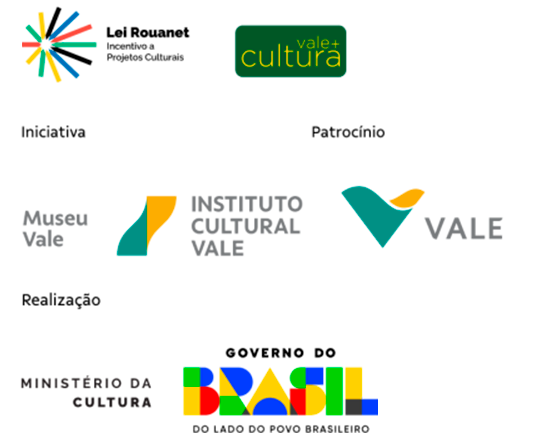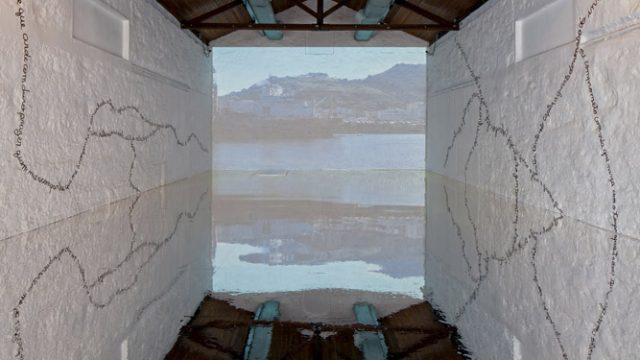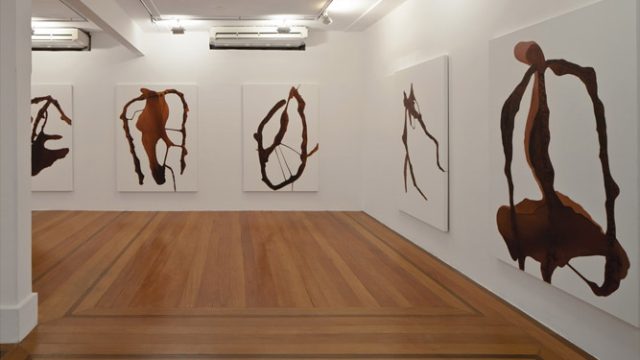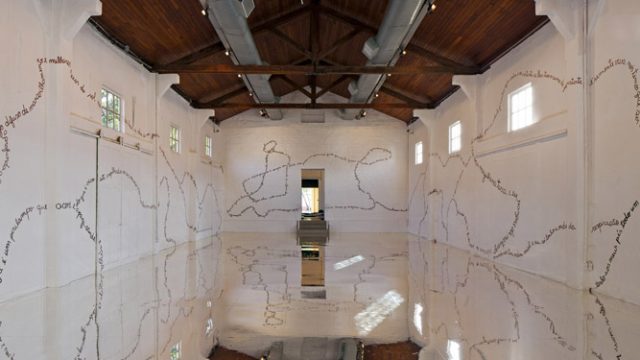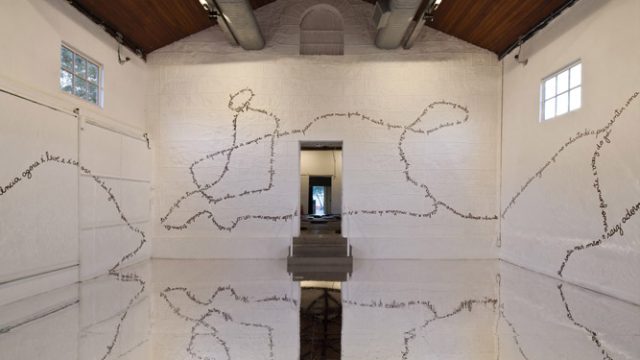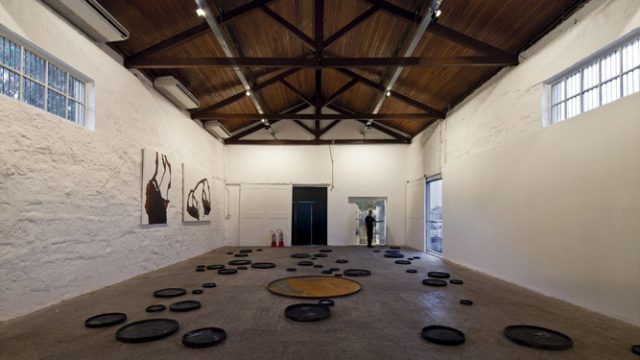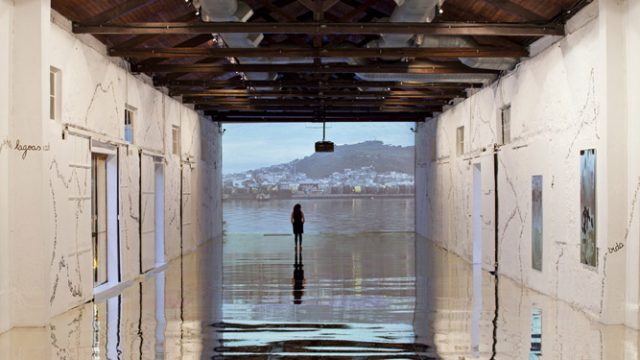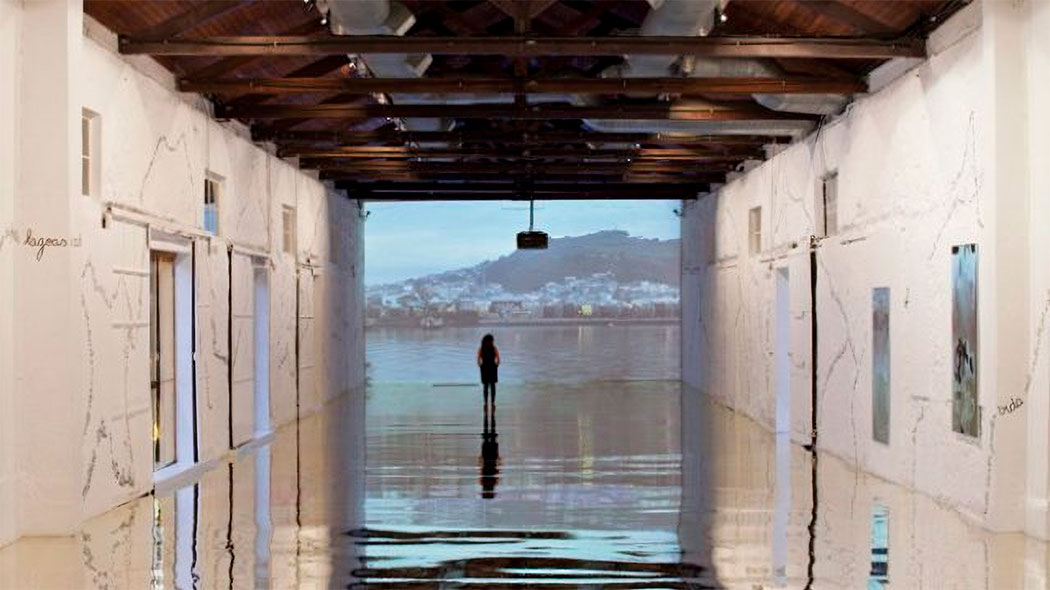
The Vale Foundation, through the Vale Museum, presents the exhibition “Água Viva” by Shirley Paes Leme. An artist from Minas Gerais, Shirley has an intense and diverse background, strengthened by studies with masters like Amílcar de Castro, and travels and exhibitions in various countries, establishing a solid and ever-expanding trajectory in contemporary art.
Creating the exhibition “Água Viva” especially for the Vale Museum, Shirley Paes Leme continues the theme of the International Seminars Vale Museum held in March: “If this street were mine… about desires and cities”, where she seeks to narrow interactions and exchanges of experiences with the city of Vitória, developing a twelve-year research on the use of tannin, from which the pigment is extracted to dye an object that is part of the old and traditional kitchen of Espírito Santo: the clay pot. For this, the artist had the collaboration of the Association of “Paneleiras” of Goiabeiras. Paes Leme, who has already been involved in an intriguing work with communities in various cities around the world, creates an interesting site-specific for the Museu Vale Galpão, elevating elements of local culture. Appropriating and experimenting with clay, Shirley elaborates physical forms and drawings relating to the water element.
The Vale Foundation recognizes in this initiative the principles that guide its actions: the construction and preservation of local culture and access for children and young people to processes of enjoyment and cultural and artistic production. Part of the Vale Foundation’s proposal is to value and strengthen regional cultural identities through the preservation of the memory and historical-cultural heritage of the places where Vale operates. This exhibition is an example of how art can address important issues for experiences in the contemporary world.
Vale Foundation
Curator
“Água Viva” is the title of a book written by Clarice Lispector in 1973. Shirley Paes Leme borrowed the title for this exhibition and used phrases extracted from the book as part of her own work, thus showing respect and conveying her admiration for the great Brazilian author. Clarice’s texts explore language deeply as a direct expression of human existence. By using various materials and media, Shirley Paes Leme launches an investigation into the human condition in our environment.
The theme of the exhibition is water, in all its versatile aspects. The installation “Água Dura”, located in the first gallery, contains various ceramic pots arranged randomly on the floor, near a large iron pot containing chemical residues resulting from the evaporation of tap water. Local ceramists, traditionally known as “paneleiras”, impregnate their products with an agent extracted from the mangrove tree bark. The installation alludes to the old notion of the four elements: Earth (clay or ore), Water, Fire (referring to the use of kilns), and Air (evaporation). This process has become part of a sculptural manifestation.
In the adjacent space, the installation “Olho d’água” provides a dramatic reinterpretation of the title, which originally describes a meeting point where water is supplied for both humans and animals. The space here is entirely enveloped by illuminated aluminum blades that construct an infinite optical delirium, creating an almost physical experience of being sucked into a whirlpool and thrown into an abyss.
In the long hall of the second gallery, the installation “Água Viva” is conceived as a suggestion and stimulus for communication between humans and their surroundings. Here, the artist makes a connection between visual poetics and the mangrove swamps on the nearby coast. Shirley Paes Leme recites the words of Clarice Lispector, shaping inscriptions on the walls to evoke the roots of the mangrove reflected in the bright aluminum “water” blades. The space also contains a real-time projection of the seascape outside the museum, thus pleading for a fluid interrelation between the museum and its surroundings.
The large-scale drawings, all belonging to the “Fontes” series, are located on the upper floor of the administrative building. The gesture of the drawings reflects on the figure of growth, taken from the mangroves. By using ink and resin derived from mangrove tree bark, the artist tries to emphasize her theme to the fullest. The title “Palavra d’água” for the drawings on aluminum suggests something similar to an artistic oracle born from water.
Release
The artist presents “Água Viva”, an exhibition that will transform the museum into a liquid and watery place that interrelates literature, city, belonging and memory. Shirley Paes Leme occupies the Vale Museum starting in June with an exhibition that stimulates and challenges the public to construct its own way of perceiving reality, while elevating elements of local culture. In a room with a mirrored floor, people find themselves facing reflected and inverted images—not only of themselves but also of the environment. The viewer, guided to navigate the interrelation of the work with the place, becomes part of this real and virtual space. This marks the beginning of the “Água Viva” journey, an exhibition by Shirley Paes Leme that the Vale Museum hosts from June 1 to August 12, initiated by the Vale Foundation and sponsored by Vale. The exhibition, curated by Jürgen Harten, brings together four different sensory experiments conceived by the artist, who was a student of Amílcar de Castro at the School of Fine Arts of the Federal University of Minas Gerais. Shirley has been exhibiting in Brazil since 1975 and in various countries since 1983, collecting significant awards.
Heterotopia and perception
Since 1984, Shirley has been developing studies and research on the concept of heterotopia, developed by the philosopher Michel Foucault. In 1986, she chose this subject for her doctorate. According to Foucault, heterotopias are specific spaces situated “within” everyday social spaces but with different and sometimes opposing functions. These spaces, gathering remnants of various other spaces and times, form a set that escapes the everyday and allows various parallel experiences. Sounds, lights, images, and human bodies in motion or still weave a network of energies that interact with each other and create a new space. “Research on spaces is ongoing and continues to this day”, explains the artist, who maintains a study group on the topic in São Paulo, with members from various Brazilian states and other countries.
The exhibition
Right at the entrance, the artist proposes a reflection on water and its absence: the installation “Água Dura” houses ceramic containers specially crafted by the traditional “paneleiras” (female potters) of the Goiabeiras neighborhood in Vitória/ES, with whom Shirley Paes Leme has been working for over a year. At the bottom of the containers, there are dried residues of water collected from the taps of the city of Vitória/ES. These residues form random patterns due to the contrast between their light color and the dark color of the clay pots’ bottoms.
On the walls of the room with a mirrored floor, drawings made with ink extracted from the bark of local mangrove trees—a material that Shirley has been researching for 12 years—display intertwining lines with a maze of words and phrases extracted from Clarice Lispector’s book “Água Viva”, which gives the exhibition its name. “The drawings on the walls contain references to literature, poetry, human-made creation, and direct perception of nature”, notes the artist. Thus, they bring forth the question of the forms of knowledge and understanding of the world and the human need to continually position oneself, seeking to understand permanently what surrounds them, contextualized with the space and place where they live. A film projection completes the room.
“The mirrored floor functions as a heterotopia, transforming this place, the one I occupy when I see myself in the mirror, into a space that is both absolutely real (associated with the entire space surrounding it) and absolutely unreal, as perceiving the real requires crossing this ‘virtual point’ that is on the other side of space”, reflects Shirley, quoting Foucault: “There is a fusion of the individual’s image with the image of the place incorporated into the landscape. The individual looks for themselves in space and, looking from above, perceives a distortion of their image and the image of the place. They are inserted into the image in another way, in another position. There is a reflection of the image of their body and the architectural body of the place”, says Shirley Paes Leme, aiming to stimulate the creation, by the audience, of a “place” where “a live and active relationship of pleasure and experimentation” takes place.
For Shirley, seen from a distance, the mirrored floor—this “wet” surface—resembles a sea that accepts the steps of a passersby who, from inside this room, can see the sea and the entire landscape around the museum, questioning the discernment between the real and the unreal.
The next room, small and entirely mirrored, simulates in the viewer the sensation of being in a deep well. “The feeling is of a loss of ground, which in a way reflects this contemporary ‘abyss’ in which one currently lives, with few certainties and constant change”, explains Shirley. The last room, located on the third floor of the museum, displays drawings on canvas on its walls, produced with the same ink made from the bark of mangrove trees that was used for the writings in the first room.
Dialogue with the surroundings
In creating “Água Viva” especially for the Vale Museum, Shirley Paes Leme sought to intensify interactions and exchanges of experiences with the city of Vitória. In addition to collaborating with the “paneleiras” of Goiabeiras and using ink extracted from the mangroves of the region, Shirley Paes Leme will conduct a workshop for the public. Anyone interested—art students, “paneleiras”, the general public—can participate. The workshop will address the poetics of the works presented in the exhibition, including a practical and playful component. There will also be performances throughout the exhibition period, with proposals made by the educational team to scheduled visitors and through spontaneous actions encouraged among the general public. The artist will also undertake various actions with the local community, including workshops for the “paneleiras” of Goiabeiras and for teachers from the municipal and state education systems, as well as performances with students from UFES (Federal University of Espírito Santo) and the community at large.
The artist
Born in 1955, she began her artistic education in 1975 at the Fine Arts course at UFMG (Federal University of Minas Gerais) and was a student of Amílcar de Castro. Between 1981 and 1986, she traveled to various countries, studied at the University of Arizona in 1983, at the San Francisco Art Institute, and at the University of California, Berkeley, in 1984. In 1986, she earned a Ph.D. in Arts from J.F.K. University, Berkeley. She was a Fulbright Foundation scholar from 1983 to 1986. She creates drawings, interventions, performances, and installations. She has received several awards at major Brazilian and North American exhibition halls. She holds solo exhibitions in Brazil and abroad. She has participated in group exhibitions since 1975, with highlights including Novos Valores da Arte Latino-Americana at the Museum of Art of Brasília, 1989; Bienal de Lausanne, 1993; VII Bienal da Polônia, 1995; Deux Artistes Brésiliens: Amílcar de Castro et Shirley Paes Leme, Paris, 1996; Die Anderen Modernen, Casa das Culturas do Mundo, Berlin, 1997; and Tridimensionalidade na Arte Brasileira do Século XX e Diversidade da Escultura Brasileira, Itaú Cultural, 1997. In 1999, she participated in the Artist in Residence program at Kunstlerhaus Bethanien in Berlin. In 2000, she participated in the II Bienal do Mercosul, Porto Alegre; VII Bienal de La Habana, Cuba; Mostra do Redescobrimento – Brasil +500, São Paulo, and Século XX: Arte do Brasil, Fundação Calouste Gulbenkian, Lisbon, Portugal. In 2001: Bienal 50 anos, São Paulo; and Côte à Côte – Art Contemporain du Brésil, musée d’art contemporain de Bourdeaux, France. Among her most recent solo exhibitions are Horas, Galeria do IAV (Goiânia, 2010); “Heterotopias Cotidianas”, Dragão do Mar Arte e Cultura (Fortaleza, 2009); “Ambulantes: Estructura-Acción”, Urban Intervention, Mexico City, (Mexico, 2008); “Endless End (Fim sem Fim)”, Sesc, (São Paulo, 2008), and Desenho: Atitude, Nara Roesler Galeria de Arte, (São Paulo, 2007).

Contact us
Social networks

